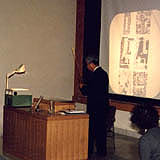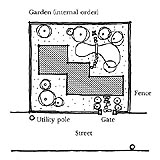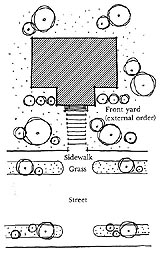 |
 |
 |
 |
| Final lecture at the University of Tokyo. |
 |
| Typical layout of urban residential townscape in Japan. |
 |
| Typical layout of urban residential townscape in the United States. |
|
 |
 |
Ashihara Yoshinobu *1
Final Lecture: Department of Architecture, University of Tokyo
February 2, 1979
(translation by Lynne E. Riggs)
Part 1
The Order of Space: Inside and Outside
The nearly nine years have passed rapidly since I came to the University of Tokyo in 1970, and already it is time to give my last lecture. I didn’t really lecture to undergraduates but rather to graduate students, so, for this, which is more like my final graduate school lecture, I’d like to consider my ideas about the problem of space. As an architect who sees space in terms of its substance, I’ll look at certain factors in the composition of space and consider how I see the nature of space itself.
There are various definitions of architecture, and the usual ones mention a structure with a roof and walls, interior space demarcated in some way from the surrounding landscape, and so on—in other words, something solid. To be sure, it is rather difficult to include a huge sculpture or an electric transmission tower, which lack interior space, in the category of architecture. From the architect’s point of view the usual, most commonsensical definition is space created by putting in place three elements: floor, walls, and ceiling/roof. In that context, the role of walls as prescribing architectural space is extremely significant. Wherever you may put up a wall, you will create inside and outside. Architecture can be described as the technology of building walls to create interior space out of the immensity of nature. If these definitions apply, then the fact that architecture is not of infinite size says something about the great significance of the element that is the wall.
In explaining this, I often point to the differences in ideas about interior and exterior space between Japan and Western countries—ideas that have fascinated me for a long time. To take one example: In Japan, when we come home, we take our shoes off. Leaving our shoes in the entryway, we step up into our homes, and with this act we feel that we have entered interior space. The notion that we are in exterior space when we are wearing shoes has become deeply ingrained in us out of long-practiced custom. This is rather distinct from the sense of space as ingrained in people of Western cultural traditions. Japanese philosopher Watsuji Tetsuro (1889-1960) called attention to this difference in his famous work Fudo [Climate and Culture: A Humanistic Study] (1935), a book I highly recommend to all of you for its many insights on culture and climate.
The fact that space Japanese think of as interior space may be considered exterior space by people of the West can be illustrated by the example of the traditional-style Japanese inn and the modern, Western-style hotel. Even Japanese inns these days are built of reinforced concrete and have become quite modern in every way, and once you enter, you find yourself in a nicely appointed, carpeted lobby. When we consider the order of interior space in a Japanese inn, however, we note that guests remove their shoes in the entryway. Then, even though they have private rooms of their own, when they go to bathe in the large common bath—walking through the corridors, riding the elevator, or crossing through the lobby—they think of themselves as being in interior space. The reason they think that way is that they took their shoes off in the lobby upon entering. Another reason is that the interior order of these modern inns is governed by fact that their amenities revolve around a large, jointly used bath, ideally with a pleasant view of mountains or valleys, the sea, or some such outdoor scene, which is considered preferable to small private baths for each individual room.
As we all know, this contrasts with the situation in an international hotel, in which we keep our shoes on all the time. The entrance lobby of such a hotel, therefore, is an extension of the exterior order of the city outside its doors, and it is in a way exterior space. We think of the private, interior order as beginning only after we enter one of the individual rooms and lock the door. We feel, I am convinced, that the other spaces in an international hotel—the elevators, corridors, and the lobby—even though in a Japanese inn we think of them as interior space—are governed by the order of exterior space.
This concept can also be illustrated by the look of residential districts in Japan vis-à-vis other countries. For example, if you walk along a street in Japan, you will find that each property is surrounded by a wall or fence. For residents, the area within a fence is interior space, the private space that belongs to them. Within those bounds they can do as they wish, for this is unmistakably interior space, or at least they think of it as such.
By contrast, if you walk along a residential street in the United States or Australia, you find quite a different sight. From the street, the pleasant-looking houses are in plain sight and in front of the house is usually a lawn or front garden. One might wonder to whom this garden belongs. Upon entering one of these houses, you often find that it is difficult to see the front garden although people walking along the street can see it very well. Indeed, people pay special attention to their front gardens, knowing that an unkempt garden can invite censure. In some towns, indeed, prizes are awarded for beautifully kept gardens. This space, while it is without doubt part of the front of the house, is qualitatively speaking, and in the minds of citizens of the town, exterior space. The space itself is the same, but is thought of in very different ways.
The same sort of distinction can be observed for university campuses. In the United States, if you go to visit a college campus, you may not be clearly aware of the demarcation line between the town and the campus; walking along, you just find yourself among university buildings, and if you just keep going, you might suddenly find yourself back in a residential area. The different departments or faculties of the university, moreover, may have completely different street addresses. You can even get a ticket for illegal parking on a street on campus! In this sense, what we might call exterior space reaches right into university campuses in the United States.
Japanese universities, by contrast, are invariably encircled by fences and accessed through gates. The University of Tokyo, for example, has its Main, Akamon, Tatsuoka, and other gates. What this means is that the space in front of a U.S. university’s architecture department building and the space in front of our No. 1 Faculty of Engineering building, even though they are essentially the same kind of space, are qualitatively quite different. What this means is that the presence of a surrounding wall and gates signal that the space within is interior space. So, should outsiders enter into that space, the faculty as well as the students may feel as if their private space has been violated, in the way family members feel when a stranger comes into their home. It is as if there were a place at the gates where students and faculty checked their shoes in a figurative sense before coming onto the campus, stepping into what they think of as “interior” space. This may seem a strange notion, but it helps describe my idea about space. In other words, the atmosphere on this campus can be described as the “Japanese-inn” type.
It is not a question of the inn-type being better and the hotel-type worse, or vice-versa. There are times when you stay at a traditional inn in Kyoto, and you enjoy the gracious, slow-paced old-capital hospitality at its best and come away satisfied and refreshed. There is a time and place for this kind of experience, when you can spend time in a leisurely fashion without having to be concerned about external pressures. But when you are involved in business or various activities in the city, the hotel-type arrangement is sometimes more convenient, and certainly the same principle may apply in the case of universities.
In Fudo, Watsuji Tetsuro reflects from the impression of his travels that in Europe there is “no distinct barrier” between interior and exterior space. He touches on the possibility that this may be the reason the idea of urban planning was very advanced there. If we translate this idea into our own Japanese context, however, it would be tantamount to walking into a house with one’s shoes on or walking into the town in one’s socks or bare feet. In his chapter “Distinctive Monsoon-culture Types” he discusses this contrast.
|
| |
[In the West] one step out of one’s room is little different from being in the family dining room, in a restaurant or out in the town. In other words, even the dining room of a home is “outside” in the Japanese sense of the term, and restaurants or opera houses play the role that sitting rooms or parlors might in Japanese homes. While, on the one hand, that which corresponds to the Japanese “home” may be little more than the area shut behind the door of an individual’s room, on the other, the family circle in the Japanese sense extends in the West to the entire town or community. However, this is not an example of “relations without individual distinction” but of social interchange among distinct individuals. Yet even if “outside” means outside an individual’s own room, in terms of the larger community it means “inside.” The public parks of a town in the West are also traditionally “inside.” One might say that what corresponds to a Japanese house and its surrounding fence in the West begins, on the one hand, at the very walls of an individual’s bedroom and extends, on the other, to the city walls or the castle moat. Here the Japanese entranceway is equivalent to the main gate of a castle town. Therefore the houses that exist in the space between the “room” and the “castle walls” are not of such great significance.
|
|
And he goes on,
|
| |
Japanese may have learned European ways of life on the surface, but, insofar as they remain bound by the household and cannot carry on a socially oriented lifestyle based on individualism, they can hardly claim to have become truly Europeanized. You may cover the streets with asphalt, but that doesn’t mean that people will decide it is permissible to go out in their stocking feet. And even if shoes are worn inside, neither is anyone likely to think that shoes are to be worn on the surface of tatami floors. In other words, who is there who would treat “inside the house” and “inside the town” in the same way? As long as the town is considered outside the household, the Japanese lifestyle cannot be considered European.*2
|
|
Going back to the three elements that prescribe space mentioned earlier—the floor, wall, and ceiling/roof created by the architect—or the question of external space that so fascinates me, space can be created only with wall and floor, omitting the ceiling, and as I said earlier, the wall has very special significance when it comes to architecture.
A newspaper article once reminded me of the amusing rakugo story of the carpenter who was driving a nail into the wall to hang up a picture, only to have it sink into the back of the household altar of the tenement house next door. This is the famous story of “The Careless Nail.” The article reported how a Frenchman who heard this story expressed great amazement that Japan had nails so long as to pass through a wall—imagining walls as he knew them in his own country. It then went on to relate Marcel Aymé’s famous “Le Passe-muraille” [The Walker-through-Walls] story of a French civil servant who acquires the power to freely pass through walls. Having suffered the constant nagging of his supervisor, one day he gets an idea for revenge and places himself in the wall with only his head sticking out into the supervisor’s room. Hearing this story, the article continued, it is now the turn of the Japanese to be perplexed. While the fantasy is understandable, how a human being could get into a wall—which we naturally envision as very thin—is puzzling. Most informative about this article, however, was the report that the walls of homes in Europe are very thick: the dividing walls between units in semidetached houses or townhouses in the London suburbs is an average of 70 centimeters thick. The standard exterior wall of German homes is 49 centimeters thick, while interior walls are approximately 24 centimeters. The area occupied by the walls therefore accounts for 20 percent of the floor plan in such cases. To me, these are very interesting figures, and when you go to Europe, you can see this for yourself. The walls are thick, and when you stay in a hotel, the door may be double, and it closes with a key that closes with a resounding clank. Back here in Japan, the doors in a Japanese inn just slide shut with a “whish”—quite a difference!
This may all be very impressionistic, but it does get at the fact that the image of the wall in Japan is probably more closely associated with the “transient abode” described by Yoshida Kenko (1283-1350) in his Tsurezuregusa [Essays in Idleness], in which a sense of oneness with nature and the feel of the seasons within the house is prized—the sight of blossoms of spring, the evening cool of summer, the bright moonlight of autumn, and the hushed snowfall of winter. While much is written in the West from the existentialist point of view and from many philosophical points of view, about the stalwart, protective qualities of the wall—Gaston Bachelard, Otto Friedrich Bollnow, Martin Heidegger, and so on—in Japan, its presence in literature is more along the lines of something far thinner and less substantial—something that whishes, if you will!
There are, of course, many reasons for this, but today I shall not go in the details. The difference comes down, as you well know, to the difference between masonry and post-and-beam architecture, the choice of the latter in the case of Japan being affected by its damp climate and other factors, meaning that the sense of a wall as something solid or protective was not much part of our cultural consciousness. By contrast, it is easy to understand how, following the traditions of masonry construction, the idea of walls as very sturdy and of walls as protective of life should have become established in the West. These ideas, as very familiar to graduate students of this faculty, have been famously articulated by Otto F. Bollnow and Gaston Bachelard. Descriptions such as the following by Bachelard, for example, evoke walls as shutting out the cold and storm outside and sheltering the warmth within:
|
| |
The house was fighting gallantly. At first it gave voice to its complaints; the most awful gusts were attacking it from every side at once, with evident hatred and such howls of rage that, at times, I trembled with fear. But it stood firm . . . and stood up to the beast. . . . the house clung close to me, like a she-wolf, and at times, I could smell her odor penetrating maternally to my very heart. That night she was really my mother.*3
|
|
Such walls have to be quite sturdy and thick. Ideas about such sturdy walls extended to the walls that surrounded the castle towns in Europe; the presence of city walls, in terms of urban geography, can be seen as developing especially in regions with a dry, temperate climate. In any case, it is only natural that in places where citizens built ramparts around their cities, piling up blocks of stone one at a time and creating thereby a convergent, introverted quality of space, and in places where castles were not surrounded by walls and where the space opens out in radial fashion from the center, as in Japan, there should be somewhat different ideas about space.
*1. Japanese names in this translation are given in traditional order, surname first.
*2. Here and above, as quoted in The Aesthetic Townscape (Massachusetts Institute of Technology, 1983), p. 20.
*3. Otto F. Bollnow, Neue Geborgenheit; das Problem einer Uberwindung des Existentialismus [A New Sense of Security: The Existential Approach to the Problem of Conquest] (Stuttgart: W. Kohlhammer, 1960), p. 165.
|
|
 |